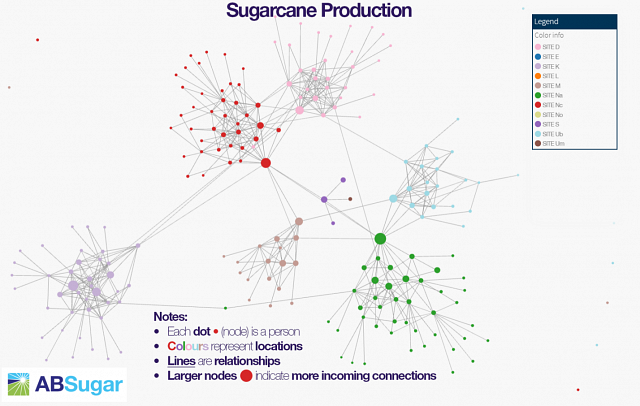Blog
23 February 2018
Increasing collaboration through understanding our social networks

A blog from our Human Resources Director, Quintin Heath
AB Sugar aims to maximise both the local ownership of business performance and the sharing of good ideas and technology across the Group. We have found that purposeful networking boosts collaborative effectiveness while also enhancing engagement through a sense of connection and shared purpose.
Our challenge was to promote that type of networking when employees are in 10 different countries on four continents - whilst retaining their autonomy. While we think that we have achieved this through developing Communities of Practice, how can we know if these are truly effective? We turned to Organisational Network Analysis and we saw ways in which to retain autonomy and enhance the collaborative flow.
The business started in 2012 to develop international Communities of Practice designed to create connections between individuals with a practice or type of job in common, and to encourage them to share their good practices, promote knowledge sharing and solve problems across the business.
For example, a chemical engineer in one part of the organisation may wonder why something is not working well. The communities allow him or her to post a query, and then for others in the same job, or a different job using similar expertise—even halfway around the world—to give an answer. Some of these questions require experience or specialist knowledge that the individual (or their boss) may not have access to, but which a handful of people in the business as a whole may have had.
These communities are supported by an electronic platform that enables employees to locate groups and individuals in different jobs or roles who can help them draw on the knowledge, experience, and support available company-wide. If no community of practice group exists for their job, expertise area or concern, employees can create a new one.
Each strategic community has an annual activity plan, a steering committee, an HR facilitator, community facilitators and designated ‘champions’ who monitor discussion threads and recruit people in their locality to take part in the webinars and other offerings. The champions also play an important role in sharing insights with the facilitator on the issues and problems in their local area, this gives rise to the development of a stronger activity plan for the community.
We have been vigilant to ensure that our use of technology is driven by the community plan, and not the reverse, and the response has been remarkable: 60% percent of people in the community are active every three months. We now have 180 different groups, with 2,000 managers engaged in the community and receive on average 190,000 page views each year. The scale of the size of conversation has doubled in the past 12 months.
So are these communities effective?
To answer this question we have developed two approaches focused on understanding how value is created and how the communities connect.
For the first, we surveyed participants on how the communities create value, using the ideas of Etienne Wenger and Beverley Traynor (http://wenger-trayner.com). For the second, we worked with Connected Commons and Rob Cross using Network Analysis, where managers were surveyed about who they connect with to help them.
This revealed a web of connections that could be analysed and visualised to understand how people are joined (see picture below). We can then assess whether the appropriate level of collaboration is occurring, whether a particular community’s champion(s) is well connected, or whether there are other people who would be great champions. As a result new champions are recruited and networks grow.
In the image below, the Network Analysis also identified holes in the knowledge base of AB Sugar’s African sugar cane sites by looking at a distinct set of agricultural practice communities with weak ties to one another. Armed with that data, the AB Sugar team set up specific communities and developed activity plans to fill those holes, recruiting champions to promote them.
Did we know of these issues before investigating? To some extent we did and this enabled the right questions to be asked in the Network Analysis. However, the data allowed us to be far more precise in our solutions.
Critical to the success of Network Analysis is having very clear questions to answer upfront. So much information comes out of the analysis that you can get swamped. Choose your questions carefully and you won’t get lost in the data.

Organisational Network Analysis revealed that agriculture within AB Sugar’s African sugar cane sites had weak cross-regional ties. In response, we created a ‘Community of Practice’ to support collaboration and engagement among peers, as well as promote connections between employees.
Notes to editors:
Quintin Heath presented AB Sugar’s Network Analysis success story at the Connected Commons Fall Forum, which took place at the Gates Foundation 10-11 October 2017 in Seattle, USA. To learn more about organisational network analysis, please visit www.robcross.org and www.connectedcommons.com.
In the coming weeks Quintin will be presenting at the Corporate Research Forum ‘What is Organisational Culture and why should we care?’ event taking place on 23-24 April 2018.















